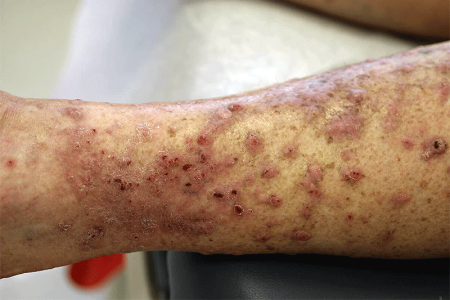Prurigo nodularis: Signs and symptoms
Where does prurigo nodularis develop on the body?
Prurigo nodularis causes itchy bumps on the skin, which appear when someone repeatedly scratches, picks at, or rubs their skin. These itchy bumps, which dermatologists call nodules, can develop anywhere on skin that you scratch, pick, or rub.
While the itchy bumps can develop anywhere, most appear on skin that’s easily scratched, such as on the:
Arms
Legs
Upper back
Lower back
Buttocks
Abdomen
What are the signs and symptoms of prurigo nodularis?
The following describes what you may experience if you have prurigo nodularis.
Itchy skin
Before the itchy bumps of prurigo nodularis appear, the skin often itches. This itch can be long-lasting or come in short bursts. Either way, it's often intense. Some people have a few itchy areas. For others, the itch covers much of their skin.

Skin may burn or sting
Instead of feeling itchy, some people say that their skin burns or stings. While rare, patients have said they experience other sensations, like the feeling that bugs are crawling on their skin.

Itchy bumps (nodules) develop
The repeated scratching, picking, or rubbing leads to itchy bumps, which tend to appear after you’ve been scratching, picking, or rubbing for a while. You’ll usually see the bumps develop evenly on both sides of the body.

Itchy bumps vary in color, size, and number
The bumps can be the color of your skin, pink, red, or brownish black. The size may vary from that of a pinhead to larger than a U.S. quarter. It’s possible to have a few bumps or more than 100 on your skin. For most people, this number falls somewhere in between.

You may see more than bumps
Raised and itchy patches called plaques, open sores, scabs, and areas where the skin is scraped or raw can develop. Your skin may feel tender or painful.

Scratching can change the skin
The more you scratch, the itchier your skin may feel. Some people scratch until the itchy bumps or patches break open and bleed or the skin feels too painful to touch. All this scratching can cause changes to your skin. Dark spots may appear. The skin can feel pebbly or hard and thick.

Dark spots, light spots, or scars can appear as the bumps clear
Without treatment, the itch and bumps can last for months or years (A). As the bumps clear, you may see flat spots (B) that are darker or lighter than your natural skin color, or scars where the bumps once were.

Some people have a greater risk of developing prurigo nodularis. Find out if you do, at: Prurigo nodularis: Causes.
Images
Images 1, 2, 5: Getty Images
Images 3, 4, 6, 7: Used with permission of the Journal of the American Academy of Dermatology and JAAD Case Reports:
J Am Acad Dermatol; 2001;44:471-8.
J Am Acad Dermatol; 2013;69:426-30.
J Am Acad Dermatol; 2020;83:1559-65.
JAAD Case Reports; 2019;5:471-3.
References
Elmariah S, Kim B, et al. “Practical approaches for diagnosis and management of prurigo nodularis: United States expert panel consensus.” J Am Acad Dermatol. 2021;84(3):747-60.
Huang AH, Williams KA, et al. “Prurigo nodularis: Epidemiology and clinical features.” J Am Acad Dermatol. 2020;83(6):1559-65.
Legat FJ, Weisshaar E, et al. “Pruritus and dysesthesia.” In: Bolognia JL, et al. Dermatology. (4th edition). Mosby Elsevier, China, 2018: 115-6.
Leis M, Fleming P, et al. “Prurigo nodularis: Review and emerging treatments.” Skin Therapy Lett. 2021;26(3):5-8.
Mullins TB, Sharma P, et al. “Prurigo Nodularis.” [Updated 2020 Sep 15]. In: StatPearls [Internet]. Treasure Island (FL): StatPearls Publishing; 2021 Jan.
Qureshi AA, Abate LE, et al. “A systematic review of evidence-based treatments for prurigo nodularis.” J Am Acad Dermatol. 2019;80(3):756-64.
Silverberg JI. “Nummular eczema, lichen simplex chronicus, and prurigo nodularis.” In: Kang S, et al. Fitzpatrick’s Dermatology. (9th edition) McGraw Hill Education, United States of America, 2019:388-92.
Whang KA, Le TK, et al. “Health-related quality of life and economic burden of prurigo nodularis.” J Am Acad Dermatol. 2021;28:S0190-9622(21)01028-8.
Yosipovitch G and Kwatra SG. “Itch associated with systemic disorders.” In: Living with itch: A patient’s guide. The Johns Hopkins University Press. United States, 2013:75."
Written by:
Paula Ludmann, MS
Reviewed by:
Brendan Camp, MD, FAAD
Raj Chovatiya, MD, PhD, FAAD
Brian Kim, MD, FAAD
Ata Moshiri, MD, FAAD
Carla Torres-Zegarra, MD, FAAD
Last updated: 4/1/25
 Atopic dermatitis: More FDA-approved treatments
Atopic dermatitis: More FDA-approved treatments
 Biosimilars: 14 FAQs
Biosimilars: 14 FAQs
 How to trim your nails
How to trim your nails
 Relieve uncontrollably itchy skin
Relieve uncontrollably itchy skin
 Fade dark spots
Fade dark spots
 Untreatable razor bumps or acne?
Untreatable razor bumps or acne?
 Tattoo removal
Tattoo removal
 Scar treatment
Scar treatment
 Free materials to help raise skin cancer awareness
Free materials to help raise skin cancer awareness
 Dermatologist-approved lesson plans, activities you can use
Dermatologist-approved lesson plans, activities you can use
 Find a Dermatologist
Find a Dermatologist
 What is a dermatologist?
What is a dermatologist?